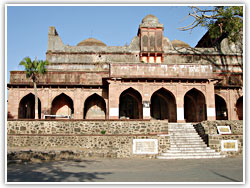|
|
Ujjain, Madhya Pradesh
.............................................................................................................................................................................. |
|
Information about Ujjain |
|
Ujjain is the quiet and relatively small
provincial town. Ujjain is situated about 60 kms.
from Indore. Ujjain is one of the greatest cities
of ancient India and one of the seven sacred
cities of Hindus in India. It is also one of the
four towns where the Kumbh Mela is held and plays
as a host up to a million pilgrims who gather on
the place every twelve years. Various people came
here to bath in the Shipra river and worship at
the temples on its banks. According to Hindu
astronomers, it is also the city from where the
Tropic of Cancer pass. This explains the presence
of the observatory (Vedha Shala) built by the Raja
Jai Singh of Jaipur in 1725. Even today, the
Ephemeris tables (predicted positions of the
planets) are published here. Ujjain is also known
for industry and crafts. The best season to visit
Ujjain is from October to March.
History of Ujjain |
 |
|
|
According to legend, the gods and the
demons once churned the ocean for Kumbha (a pot of
divine nectar). First emerged a pot of vish or poison.
The Lord Shiva drank it down. The poison was so strong
that his divine neck turned blue and he was known as the
Nilkantha or the blue-necked one. It all happened at
Ujjain and that is the reason for its sacredness. In the
ancient times and in the great Hindu epics, the
Upanishads and the Puranas Ujjain was known as Avantika.
According to the legend, the Lord Siva commemorated his
victory over the demon ruler of Tripuri by changing the
name of his capital to Ujjaiyini. Ujjaiyini means one
who conquers with pride. Various dynasties like the
Sakas, Guptas, Paramaras, the governors of the Slave
Dynasty of Delhi, Mughals and Marathas ruled over this
prosperous city. It is also said to have been the seat
of the viceroyalty of Ashoka during the reign of his
father at Pataliputra (Patna) in 275 BC. Chandragupta II
also transferred his capital from Pataliputra to Ujjain.
The emperor Asoka’s sons were born here, and it was from
here that they set out to preach Buddhism. The poet
Kalidasa, wrote some of his works here and even the god
Krishna is believed to have studied here. Kalidas
described the city as the “town fallen from Heaven to
bring heaven to earth.” Ujjain was also situated on a
trade route to Mesopotamia and Egypt and consequently
trade flourished. Nowadays, it is little more than a
provincial town.
Festivals of Ujjain
The Kumbh Mela takes place in Ujjain after every 12
years in the month of April. During this fair, millions
of pilgrims from all over the country gather here for a
dip in the holy river. Kartik Mela is held in the month
of November. This fair lasts for a month and draws large
crowds from surrounding village.
Shopping in Ujjain
Ujjain is known for its dyers and printers of Bherugarh,
a suburb of the town. The Chipas produce the most
exquisite and colourful block-printed cloth for saris,
tapestries, hangings, bed-sheets and floor coverings.
|
|
|
|
Tourist Attractions in
Ujjain
There are a reasonably large number of places in
Ujjain. Some places which can be visited in Ujjain
are the Mahakaleshwar temple, Bade Ganeshji ka
Mandir, Ghats, Kaliadeh Palace, Observatory and
Maharaja Scindia’s Palace. The other famous
temples are Chintaman Ganesh, Harsidddhi Mandir
and Gadkalika.
Mahakaleshwar Temple
The Mahakaleshwar Temple with its soaring Shikhar
(tower) dominates the skyline and life |
 |
|
|
of
Ujjain. This temple is dedicated to Lord Shiva and
houses the lingam of Lord Shiva. This temple is also an
important pilgrimage centre for Hindus. This temple is
one of the 12 Jyotirlingas in India, and believed to be
swayambhu (born of itself), deriving its Shakti or power
from within itself. The myths surrounding the
jyotirlinga go back to the 2nd century BC and were
clearly developed in order to explain and justify linga
worship.
Bade Ganeshji Ka Mandir
Bade Ganeshji Ka Mandir is located close to the tank
near Mahakaleshwar Temple. This temple enshrines a large
sculpted image of Ganesh.
Kaliadeh Palace
The Kaliadeh Palace is situated about 8 km from the city
centre. The Kaliadeh Palace is built on the banks of the
Shipra river. This once imposing building was built by
Mahmud Khilji in 1458. Akbar stayed here in 1601.
Observatory
The Vedha Shala (observatory) was built by Maharaja
Sawai Jai Singh of Jaipur. This observatory is very
small as compared with Jai Singh’s Jantar Mantars in
Delhi and Jaipur and contains only five instruments.
How to reach Ujjain
By Air:
The nearest airport is located in Indore, about 53 km
from Ujjain.
By Rail:
Ujjain is located on the Bhopal–Nagda sector of the
Western Railway.
By Road:
Ujjain is connected with Indore, Ratlam, Gwalior, Mandu,
Dhar, Kota and Omkareshwar. |
|